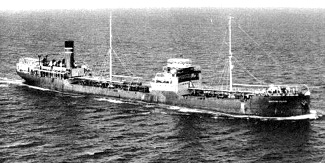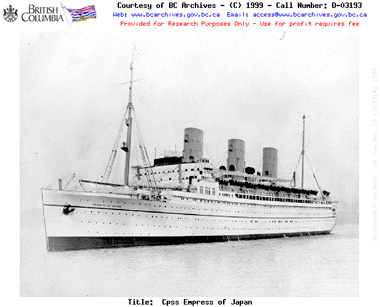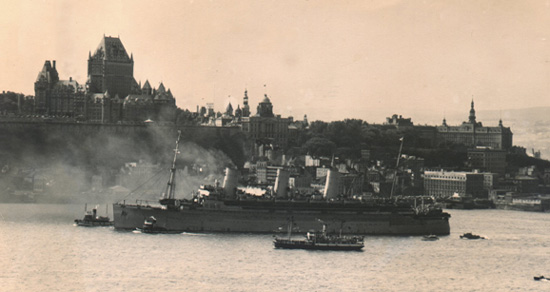STORIES OF A MERCHANT SAILOR
Part Three
 STEERING LESSONS
STEERING LESSONS

by Gordon Sollors
How many of us remember the first time we wrapped our
grubby
little fingers around the spokes of a ship's steering
wheel? I don't
mean those occasions when, as deck boys if we chanced to
be
working in or near the wheelhouse whilst the ship was
safely tied up
in port, we would surreptitiously stand at the wheel,
imagining that
we were actually steering the ship. I mean the "real
thing" when
after a few days, weeks, even months if the voyage was
long enough,
we finally talked one of the AB's who happened to be on
the twelve
to four watch on a Saturday afternoon to ask the second
mate if the deck boy could have a few minutes at the
wheel during the watch.

|
Jock was a softly spoken AB who often went out of his way to explain things to me. It had not occurred to me to ask about having a turn at the wheel until he mentioned it. I suppose that everyone has to start somewhere. Jock said he would ask the second mate (twelve to four watch) if I could come up there on the next Saturday if the weather was decent. Sure enough, Jock arranged for me to go to the wheelhouse on the next Saturday afternoon at two thirty. I suppose that even in wartime, and in convoy, people have to learn to steer, otherwise there would have been a severe shortage of capable helmsmen before too long.
Saturday afternoon came around -- the weather was reasonably decent, (there were no waves breaking over the fo'c's'le head!) I finished clearing up the dinner things and made everything ready for "smoko" tea at three o'clock. I wanted everything to be right so that no one would be asking, "Where's that bloody peggy?" I put on my best pair of dungarees, - now called "jeans" - and a big woolly jersey - I had been told I would be cold, standing at the wheel for some time. I had also been told I would only be at the wheel for about ten minutes for the first time. I took the large brown teapot to the galley, all ready to be filled with hot water and taken to the mess on my way back from my first steering lesson. I was most anxious that I should not be seen to be neglecting my "Peggy boy" duties for such frivolous things as learning to steer!
At the prescribed time I presented to the second mate and humbly asked if I could have a turn on the wheel, as "Jock was willing to teach me" The second mate was a big man, and without a word to me he put his head into the wheelhouse, (he had been on the wing of the bridge) and said to Jock "Here he is Jock, keep an eye on him!" Jock went to some lengths to explain to me about the 'midships spoke, (the one with the brass cap, or sometimes the Turk's Head on), and the amount of helm she was taking at that time. Since it was my first time at the wheel, he also went on to explain in as much detail as he thought I could absorb about the relationship between the Lubbers Line, (the mark on the brass rim of the compass, or sometimes, a little pointer fixed inside the compass denoting the ship's head,) and the mark on the compass card (number of degrees) which was the given course. He also explained to me that although we were in convoy, we were steering a given course, and not "keeping the ship ahead fine on the port bow" or whatever.
I eventually stood at the wheel of the ship and felt myself to be the most important person in the world, being responsible for steering this load of about five or six thousand tons of aviation fuel back to Britain single- handed! (I think the British Faith could be carried with ease on part of the fore deck of one of today's supertankers!) Jock stood at my side, keeping a fatherly eye on my efforts. As the ship swung off course slightly, he was there to advise on how much helm to apply to "bring her back on course". Each time the head swung away two or three degrees, say to port, I would apply two or three spokes of wheel to starboard until I could "feel" (and of course, see) the ship answering the helm. At the crucial moment, I would 'midships the wheel, and watch for the next swing away from the prescribed course. A quick look at the ship ahead confirmed that it was still "fine on the port bow" where it was supposed to be. I felt great! This was real power! After what only seemed like a few moments, the second mate popped his head into the wheelhouse and asked, "How's he doing Jock?" Jock was pleased to reply that I was doing fine. The second mate then told Jock he could go and have a smoke for a few minutes. I felt ten feet tall!
Jock had only been gone a few moments when I started to get confused between the movement of the lubber's mark and the compass card. As the ship swung say to port, the compass card (which actually remains "still") appeared to be swinging to starboard. I immediately put on port helm, making the situation much worse. I was so engrossed in what was going on within the binnacle that I didn't hear the second mate rush into the wheelhouse. I soon felt his weight as he shouldered me off the wheel yelling a few choice epithets ending up with "Get Jock up here straight away".
As I left the wheelhouse, I could see that the ship was out of line, but gently swinging back on course. The second mate had been keeping a watchful eye on my steering, so I had not been allowed to stray too far. I was devastated, and went aft to the galley where Jock, oblivious to the drama, was having a quiet smoke. I told him what had happened, but he was off before I had finished. No damage had been done, even the other man on watch who was on lookout, had not noticed anything untoward. Jock kept it quiet, so I was allowed to live down my own "shame".
The next time I stood at the wheel of a ship was "for real", and more than a year later. The ship I was on in the intervening year was the Highland Brigade. I was an Ordinary Seaman on her, but she carried quartermasters, so not even the AB's had to steer.
On April 1 1944, I joined the S.S. St. Clears as a Senior Ordinary Seaman. We had aeroplanes (in boxes) on top of all hatches, and a giant steam train on either side of the fore deck. Plus two more steam engines, one on either side of the after deck. We were bound for Abadan, and the cargo would be taken from there overland by rail, to Russia. As a senior ordinary seaman, I was expected to take my turn at the wheel. The subject of my ability at the wheel just never arose. It was assumed that as a senior ordinary seaman, I "had the knowledge". We left Liverpool and joined a large convoy. Bound, as we discovered, for Abadan via Port Said and the Suez Canal. Whatever had happened to me in the intervening year I can't say, but my steering, without any further coaching turned out to be at least, OK Having had one disastrous experience, I was better armed to avoid another!
After about three weeks at sea, we arrived at Port Said, and duly took our place in the queue of ships in the southbound convoy to Port Tewfik at the other end of the Canal. All sorts of stories went around about Canal Pilots who sent down helmsman after helmsman until the entire deck department had been tried. In our case at least, such stories remained just that, - stories! I took my turn at the wheel, and was overjoyed at the experience. Here was me, not yet seventeen, steering this lot through this famous waterway, I could hardly believe it! It was a wonderful experience, sailing as it were, through the desert with groups of British soldiers every few miles along the banks, in gun emplacements, calling out to us to throw out any old firewood! Nights are cold in Egypt!
After the Canal came the Red Sea, the Persian Gulf, and the Shat al Arab River to Abadan. By this time, I even considered myself to be "experienced". Steering ships in these confined waterways never ceased to be a thrill for me. After Abadan came Karachi, Mombassa, and Dar es Salaam. I have travelled these waterways many times since, but the experience of steering a large ship through them never ceased to thrill me.
The largest ship I ever steered was the Empress of Scotland. Liverpool to Quebec with returning Canadian soldiers in September 1945. Four days for the voyage each way, at a speed of some twenty odd knots. Using a Gyrocompass, we were allowed about two degrees "latitude" off course. More than that and a red light flashed in the wheelhouse, warning the helmsman that "big brother" was watching! If one was careless enough to stray about five degrees off course, then a bell rang out, telling all and sundry that the helmsman was asleep.

|
This photo which is from the British Columbia Archives shows Empress of Japan as she looked in 1931. This 26,000-ton passenger liner was the pride of the Canadian Pacific Railway's Pacific Fleet and during the 1930's she sailed between Vancouver, B.C., Canada, and the Orient. When WWII started, she was requisitioned by the British Admiralty, painted grey, lightly armed, and converted into a troopship. After Japan's entry into the war, Empress of Japan was renamed Empress of Scotland. |

|
Over half a century after this photo of
Empress of Scotland
was taken on September 9, 1945,
Gordon Sollors
described
this scene
vividly:
|
The nicest steering experience was steering a Liberty Ship up the St. Lawrence River to Montreal in the summer of 1947. On Liberty ships, there is a duplicate wheel on the Monkey Island which can quite easily be connected. Steering a liberty ship from such a high vantage point whilst travelling at a steady ten knots up this most beautiful waterway was unforgettable. The weather was hot, but up on the Monkey Island, we had the benefit of a cooling breeze. The pilot would give the helmsman a landmark to keep "fine on the port bow" or whatever, and retire to the wing of the bridge. I felt as if I was steering my private yacht up there!
Of course, to offset all this grandiloquent rhetoric are those countless, boring hours one has spent whilst on the wheel, gazing almost mesmerised into the little cavity of the binnacle, the large brass dome which contains the Compass, or listening to the chatter of the gyro compass as it signals yet another departure from the straight and narrow. All this whilst one is trying to take one's mind off the boring subject of steering the ship whilst one is thinking about the beautiful girl friend one was chatting up in the last port of call.
| PLEASE CLICK HERE to go to Gordon's next story about his wartime voyage aboard the troopship Orion, My First Trip to Sea, Part I: Starting Out. |
| Please Click Here to return to Gordon's first story, The Peggy. |
| Please Click Here to return to Gordon's second story, Christmas in America. |
| TABLE of CONTENTS |
| INDEX PAGE |
Gordon's pages are maintained by Maureen Venzi and are part of The Allied Merchant Navy of World War Two website.